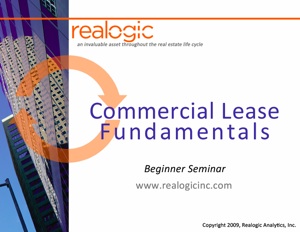As some of you may know, Realogic has offered Training Services for Commercial Real Estate professionals since its inception in 1992. At that time, Realogic offered training in Pro-Ject, which was the Property Valuation software of choice.
In the years that followed, we tried out several different types of classes. Some have focused on specific applications (like ARGUS Valuation-DCF ™ and Excel for Commercial Real Estate) and some have been focused on a subject area.
 Back in 2008, we designed an entire class based around our expertise in Commercial Real Estate leases. We pulled together our team of lease abstractors for commercial real estate due diligence and full-time ongoing lease administration professionals to collect their experiences and reduce them down to the essential lessons for a new class. A class that would teach commercial real estate professionals the nuts and bolts of the fundamental document to our industry.
Back in 2008, we designed an entire class based around our expertise in Commercial Real Estate leases. We pulled together our team of lease abstractors for commercial real estate due diligence and full-time ongoing lease administration professionals to collect their experiences and reduce them down to the essential lessons for a new class. A class that would teach commercial real estate professionals the nuts and bolts of the fundamental document to our industry.
After several months of designing a full-day class essentially teaching, “How to Read a Lease,” we added it to the roster of available sessions for the public in 2009. It was called “Commercial Lease Fundamentals” and was taught by our Manager of Training Services, Ellen Hayes.
Signups for the class were slow but we heard lots of positive feedback from our other training customers. We’d hear things like, “this is what the industry needs” and “once we start hiring, we’re sending them straight to you.” As the year went on though, the classes never quite filled up and we decided to discontinue the class after a full year of half-filled classes.
Something about the experience seemed wrong though. People still asked about the class after it was discontinued and, perhaps more tellingly, they demonstrated a need for what the class taught. Is it possible people wanted this content but felt uncomfortable signing up for a class that might make them feel insecure? We thought maybe so, which brings us to today.
Instead of charging for a full day in-person class, the contents of the class will be distributed through our blog in a series starting with this introduction. By presenting the material in this way, we can provide the contents of the class to our web visitors without anyone having to admit what they might not have known (or might have just forgotten). New articles in the series will be posted every Wednesday and will continue through the remainder of the calendar year.